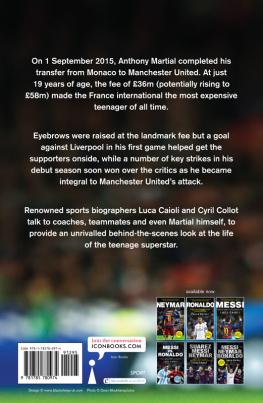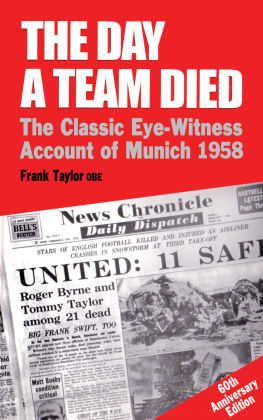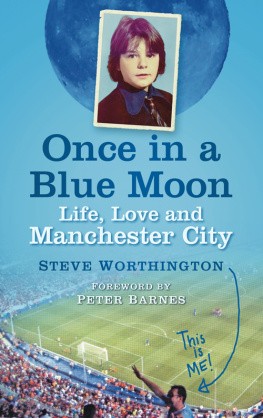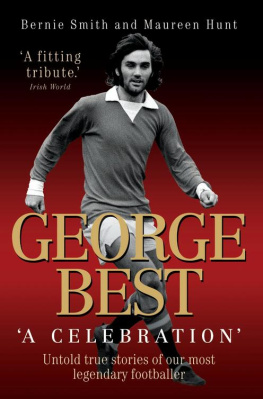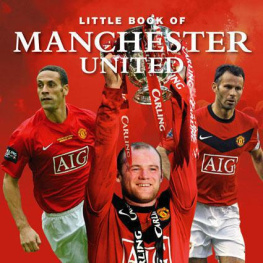First published by Pitch Publishing, 2018
Pitch Publishing
A2 Yeoman Gate
Yeoman Way
Durrington
BN13 3QZ
www.pitchpublishing.co.uk
Stuart Bolton and Paul Collier, 2018
All rights reserved under International and Pan-American Copyright Conventions. By payment of the required fees, you have been granted the non-exclusive, non-transferable right to access and read the text of this e-book on-screen. No part of this text may be reproduced, transmitted, downloaded, decompiled, reverse-engineered, or stored in or introduced into any information storage and retrieval system, in any form or by any means, whether electronic or mechanical, now known or hereinafter invented, without the express written permission of the Publisher.
A CIP catalogue record is available for this book from the British Library
Print ISBN 978-1-78531-469-8
eBook ISBN 978-1-78531-498-8
--
Ebook Conversion by www.eBookPartnership.com
Contents
Acknowledgements
When we decided back in the spring of 2015 to combine our questionable talents to write a book that chronicled the places in and around Manchester with a connection to George Best, we anticipated that this would be a fairly routine task but one worth undertaking nonetheless. Where the project moved on from the straightforward to the enjoyable is thanks to the pleasure we had chatting to those people who have been able to help us with our research.
Our biggest thanks go to Phil Hughes, Georges close friend and manager for the last 20 years of his life. Phil has given generously of his time throughout our research and has been able to point us in the direction of a number of people that George knew well and who Phil felt would have something new to say about the times George spent both living in Manchester and visiting the city in later life.
Our sincere thanks go to those people who were all able to share their personal memories of George with us, namely David Sadler, Colin Burne, Felix Izquierdo Moreno, Alex Best, Nerys Mooney, Susie Mathis, Jane Viglietti, Steve Lynton and Shaun McCarthy. We also wish to thank Michael Crick, Stephen Millership, Brian Ault, Jim Gee, Michael Rodgers, Ed Glinert, Chris Griffin of the Sale Messenger newspaper, and the staff at Ashworth Holme Estate Agents in Sale.
Numerous other people, some of whom we dont even know the names of, have been happy to share recollections with us or provide useful information while we have been pounding the avenues and alleyways around Georges old haunts around Manchester. To them all we offer our grateful thanks.
We also wish to offer heartfelt thanks to Andrew Collier, Marion Collier, Sue Butterfield, Hilda Bolton and John Bolton for their collective support during the books three-year gestation.
Introduction
When George Best first arrived in Manchester in the summer of 1961 nobody could have envisaged the impact the young Irishman would have, not just at Manchester United, but on the city itself.
This was the beginning of a decade that was to become known as the Swinging Sixties and Best was to play a major role in the citys burgeoning social scene, and in Manchesters transformation from a perceived flat-capped northern backwater into one of the countrys most fashionable locations. It was to be the best of times.
While the number of books written about the life and career of George Best could probably fill a modest-sized sunken bath, there hasnt been one which has chronicled the venues and locations in Manchester where George worked, rested and played. This volume aims to fill that gap.
We also highlight the places in the city where Best is commemorated today, and we speculate on what the future may bring as Manchester (hopefully) continues to celebrate the memory of one of its most fondly remembered adopted sons.
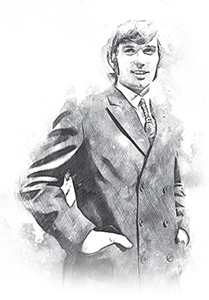
9 Aycliffe Avenue, Chorlton-cum-Hardy, M21 7WJ
The story of George Best leaving his native Belfast and arriving at Exchange Station in Manchester with fellow Irishman Eric McMordie in the summer of 1961, and their almost immediate return, has been well documented.
During their brief visit to the mainland the pair were introduced to their prospective landlady, Mary Fullaway, one of the Manchester United landladies who had been vetted by the club to provide decent lodgings for their apprentice footballers. The two young Irishmen had their evening meal at her small three-bedroomed council house and then spent the night there. However, the two teenagers found they were both overawed by the whole experience and they agreed to return home across the Irish Sea barely a day after their arrival. However, upon his return to the family home, Georges dad, Dickie, had a quiet, reassuring word with his son and they made the decision for George to return to Manchester in due course. It was a decision he didnt live to regret.
A couple of weeks later, Best returned to the city and moved back in with Mrs Fullaway, who was sharing the house with her son, Steve. Mary Fullaway was a widow following the death of her husband, Harold, who had passed away on 29 April 1952 at the age of 46. She also had an elder son called Graham who had got married and moved out the year before. The vacant bedroom led Mrs Fullaway to consider being a landlady for the club.
Georges first room-mate was a fellow native of Belfast, Ronnie Briggs, a goalkeeper who was a couple of years older than Best. Two years later George found himself with a new room-mate David Sadler and the story of how they ended up together owes a debt of gratitude to Davids own mother. Nothing strange there, you might think; surely some mothers had a say in where their sons ended up living. Except that in this instance Sadlers mum had actually died about ten years before!
Well let David take up the story from there, When I came up [north], I was put into this really nice house in Stretford more of an older couple they were. Subsequently, at some point, the old lady said to me, Dont move! Dont move, David. Your mothers behind you. Your mothers looking after you. Shes protecting you in your travels. It was all a bit spooky.
I was training with the youth team then and I went into the same category as George, playing for the A and B teams. At the time, George was in digs with Ronnie Briggs, a goalkeeper from Northern Ireland. They werent suited personally but at least they had that [background] in common. I think I had shared a room with George on a trip to a youth tournament in Zurich and wed become pretty good pals. I was having my troubles with my spooky landlady, and I was talking to George as it got to the end of the [1962/63] season because the retain-and-transfer list was going up.
Ronnie ultimately wasnt retained so I said to George, It seems like there is a vacancy with your landlady and I could do with getting away from mine! So, I got in there pretty quickly. We went and asked the club and it was arranged that when we came back for the start of the next season we would be in digs together. George had asked Mrs Fullaway. She knew she was losing a lodger so she wanted another one and so the club would have arranged it with her. In fact, it was probably Joe Armstrong who arranged it with Mrs Fullaway.
David also described the set-up at Mrs Fullaways, We shared a room and had two single beds. There was a kitchen and a front room which had a sofa and a telly in it. Upstairs, George and I had a double room. Steve had a little single room. There was obviously a bathroom with a separate toilet and another bedroom at the back.




